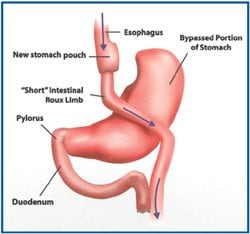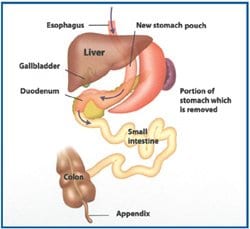Surgical Weight Loss Options
We offer a full spectrum of surgical interventions supported by the latest technology. Minimally invasive surgery offers surgeons the precision, dexterity and control of traditional surgery, but with incisions no bigger than a dime. Laparoscopic or minimally invasive surgery uses up to six small abdominal incisions through which a video camera and surgical instruments are inserted. This technique is less invasive and creates less tissue damage as it replaces the need for one large incision.
You may be a candidate for surgical weight loss if you have:
- A body mass index (BMI) of 40 or more;
- A BMI between 35.0-39.9 and a serious obesity-related health problem;
- An ability to make a variety of lifestyle changes required for weight maintenance after surgery.
Pre-Operative Requirements
Pre-Op Weight Loss
At your initial appointment, your weight and height will be measured to determine your BMI. From this day forward, you will focus on weight loss and nutrition and lifestyle changes to prepare for a successful surgery.
Nutrition Evaluation
You will meet with one of our program dietitians prior to surgery. She will assist you in understanding the diet and lifestyle changes recommended after surgery. Most insurance companies require three to six documented monthly dietitian visits prior to authorizing weight loss surgery.
Psychology Evaluation
You will meet with a psychologist who specializes in weight loss surgery evaluations. The evaluation will include an interview, psychological testing and a review of your test results.
Cardiology/Pulmonology/Other Consultations*
*We do not require a cardiology or pulmonary consultation for all patients.
If these consults are necessary, our office will assist you with scheduling.
Laparoscopic Surgery Options
Adjustable Gastric Band Surgery
During the adjustable gastric band surgery, the surgeon places an adjustable gastric band around the top of the stomach near the esophagus. The band is made of silicone rubber and can be adjusted through an access port. Through adjustment, the surgeon can increase or decrease the opening between the upper and lower stomach to restrict the amount of food ingested and the rate at which the food empties into the larger portion of the stomach. This will help you feel full sooner and remain full longer than usual. The adjustment band can be taken out if necessary.
Advantages of Adjustable Gastric Banding:
 The stomach and intestines are not cut or stapled.
The stomach and intestines are not cut or stapled.- The band can be adjusted to achieve optimal weight loss.
- Patients lose about 10-20 percent of their excess weight over the first three years.
- Adjustments are performed during an office visit.
- The adjustment band can be taken out if necessary.
Gastric Bypass Surgery
When gastric bypass surgery is performed, the surgeon creates a small stomach pouch divided from the rest of the stomach. The resulting walnut-sized pouch holds about 1 ounce of food. The small intestine is then divided and the lower part (jejunum) is connected to the newly formed pouch. This allows food to bypass the first segment of the small intestine (duodenum) resulting in malabsorption of calories and nutrients.
Advantages of Gastric Bypass:
 Effective for improving or resolving high blood pressure, diabetes, sleep apnea and many other medical issues.
Effective for improving or resolving high blood pressure, diabetes, sleep apnea and many other medical issues.- Gastroesophageal reflux (GERD) is cured.
- Most patients lost 60-80 percent of excess body weight with this procedure.
- Weight loss occurs over a 12- to 18-month period.
- Does not involve an implanted device.
Sleeve Gastrectomy
Sleeve gastrectomy removes the left side of the stomach, including the portion that produces hormones for hunger stimulation. The remaining portion of the stomach is stapled into a narrow tube or sleeve. The reduced stomach size causes a feeling of fullness after eating a small amount of food.
Advantages of Sleeve Gastrectomy:
 The small intestines are left intact, minimizing chances of intestinal blockage and ulcers.
The small intestines are left intact, minimizing chances of intestinal blockage and ulcers.- Interferes minimally with the digestion and absorption of vitamins and nutrients.
- Most patients lose about 60 percent of excess weight within a two-year period.
- Does not involve an implanted device.
- May use NSAIDS and aspirin after this surgery.
Duodenal Switch (DS)
 The duodenal switch (DS) happens when the surgeon creates a sleeve pouch and the intestines to create a short common channel (75-100 cm).
The duodenal switch (DS) happens when the surgeon creates a sleeve pouch and the intestines to create a short common channel (75-100 cm).
Advantages of DS:
- Highest rate of type 2 diabetes remission.
- Highest achieved weight loss with durability compared to other bariatric procedures.
- Less risk of marginal ulcers and ability to use NSAIDS.
- Less risk of hypoglycemia
Is surgical weight loss for you?
Learn more
To learn more about the CentraCare surgical weight management options, program pricing, insurance and next steps, view our online seminar "Surgical Weight Management."
You also may view our Frequently Asked Questions section for more information.